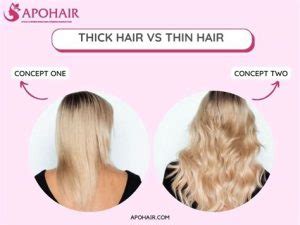Introduction
The scalp is the skin covering the skull and hair follicles. It consists of several layers, including the epidermis, dermis, and subcutaneous tissue. The thickness of the scalp can vary depending on genetics, age, and lifestyle factors.

Fine vs. Thick Scalp
The thickness of the scalp is determined by the number of layers of fat and connective tissue beneath the skin. Fine scalps have fewer layers of fat and connective tissue, resulting in a thinner scalp that is more prone to sun damage and hair loss. Thick scalps have more layers of fat and connective tissue, which provides better protection from sun damage and hair loss.
Characteristics of Fine Scalp
- Thin, delicate skin
- Prone to sun damage
- Prone to hair loss
- May be sensitive to styling products
- May have a greasy or oily appearance
Characteristics of Thick Scalp
- Thick, durable skin
- Less prone to sun damage
- Less prone to hair loss
- Can tolerate styling products better
- May have a dry or flaky appearance
Scalp Thickness and Hair Health
The thickness of the scalp can affect hair health in several ways:
- Sun damage: Fine scalps are more prone to sun damage because the thinner skin provides less protection against UV rays. This can lead to premature aging, thinning hair, and scalp cancer.
- Hair loss: Fine scalps are also more prone to hair loss because the thinner skin provides less support for hair follicles. This can lead to conditions such as androgenetic alopecia (male-pattern baldness) and alopecia areata (patchy hair loss).
- Scalp sensitivity: Fine scalps may be more sensitive to styling products, chemicals, and other environmental irritants. This can lead to itching, irritation, and inflammation.
Scalp Thickness and Lifestyle Factors
Lifestyle factors can also affect scalp thickness. For example:
- Diet: A healthy diet rich in fruits, vegetables, and whole grains can promote healthy scalp and hair growth.
- Stress: Stress can lead to hair loss and scalp problems. Managing stress through exercise, meditation, or yoga can help improve scalp health.
- Sleep: Getting enough sleep is important for overall health, including scalp health. Aim for 7-8 hours of sleep per night.
- Smoking: Smoking damages blood vessels and reduces blood flow to the scalp, which can lead to hair loss and scalp problems.
Common Mistakes to Avoid
There are several common mistakes that people with fine or thick scalps should avoid, including:
- Over-washing: Washing your hair too often can strip your scalp of natural oils and make it more prone to dryness and irritation. Aim to wash your hair 2-3 times per week.
- Using harsh shampoos and conditioners: Harsh shampoos and conditioners can damage your scalp and hair. Choose gentle, sulfate-free products that are designed for your hair type.
- Over-styling: Over-styling your hair with heat tools can damage your scalp and hair. Limit your use of heat tools and use protective products when you do style your hair.
- Ignoring scalp problems: If you experience any scalp problems, such as itching, irritation, or hair loss, see a dermatologist. Scalp problems can be treated effectively if they are caught early.
Why Scalp Thickness Matters
The thickness of your scalp can affect your hair health, appearance, and overall well-being. Having a healthy scalp is important for preventing hair loss, maintaining healthy hair growth, and protecting your scalp from damage.
Benefits of a Healthy Scalp
A healthy scalp provides:
- Protection from sun damage and scalp cancer
- Support for hair follicles and healthy hair growth
- Reduced risk of hair loss and scalp problems
- A refreshed and revitalized appearance
Conclusion
The thickness of your scalp is an important factor in your hair health and appearance. By understanding the differences between fine and thick scalps and following the tips in this guide, you can maintain a healthy scalp and enjoy beautiful, healthy hair.
Additional Information
- The average scalp thickness is 2-3 mm.
- The scalp is home to approximately 100,000 hair follicles.
- The scalp produces sebum, an oil that helps to lubricate the hair and scalp.
- The scalp is a common site for dandruff, a condition characterized by flaking and itching.
